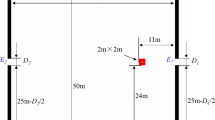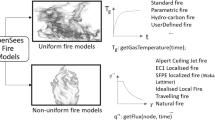Abstract
Fire risk in smart-green multi-unit residential buildings (SG-MURBs) is found to be causing a significant threat to public safety, property, and the environment. Therefore, this study developed a framework to assess and predict the potential ignition source factors that cause fire incidents (ISFs-FIs) in SG-MURBs. The framework consists of four steps: identification of potential ISFs-FIs; benchmarking; development of ANN model to predict ignition sources-related human factors and fire origin; and development of ANN model for fire impacts prediction. The ANN Simulink models were generated to simulate ANN models in Simulink or deploy with Simulink Coder tools using MATLAB. The developed framework was applied to seven cities in British Columbia (BC). The results identified forty key potential ISFs-FIs. The levels of relative frequency, total dollar loss, and risk of ISFs-FIs were determined and then benchmarked to identify the most critical factors. The results indicated that Vancouver, BC, has a very high fire risk level with 58%. Statistically significant (p < 0.005) correlation was found with a negative correlation (R = − 0.83) between elderly people and fire frequency, whereas a positive correlation (R = − 0.87) between younger people and fire frequency. Finally, two ANN prediction models are developed with R2 predictive abilities of 72% and 99%, respectively. These results assist decision-makers in enhancing fire prevention strategies accordingly.


source attributes for the seven cities, BC










Similar content being viewed by others
Abbreviations
- AC:
-
Age-group categories
- ANN:
-
Artificial neural network
- BR:
-
Bayesian regularization
- CC:
-
Contributing condition
- CFE:
-
Cause failure escape
- EP:
-
Elder people
- HEFs-FIs:
-
Human error factors that induce fire incidents
- ICOF:
-
Ignition of clothing or other fabrics
- ISFs-FIs:
-
Ignition source factors that cause fire incidents
- LM:
-
Lavenberg-Marquardt
- LP:
-
Lone parent
- NC:
-
Nature of casualties
- NFID:
-
National Fire Information Database
- PC:
-
Possible consequence
- SCG:
-
Scaled conjugate gradient
- SE:
-
Sex
- SG-MURBs:
-
Smart-green multi-unit residential buildings
- TDL:
-
Total dollar loss
- TFMI:
-
Type of fabric or material that might be ignited
- YP:
-
Young people
References
Abrahamsson M (2002) Uncertainty in quantitative risk analysis-characterisation and methods of treatment,” Lutvdg/Tvbb--1024--Se, p. 88, [Online]. Available: http://lup.lub.lu.se/record/642153
Adedigba SA, Khan F, Yang M (2017) Dynamic failure analysis of process systems using neural networks. Process Saf Environ Prot 111:529–543. https://doi.org/10.1016/j.psep.2017.08.005
Administration U. S. F.and N. Fire (2019) “Residential Building Fire Causes,” no. May
Alexandridis T (2018) Fitting data into probability distributions
Aven T, Guikema S (2011) Whose uncertainty assessments (probability distributions) does a risk assessment report: The analysts or the experts? Reliab Eng Syst Saf 96(10):1257–1262. https://doi.org/10.1016/j.ress.2011.05.001
Benichou N, Kashef A, Torvi D, Hadjisophocleous G, Reid I (2002) IERAsystem: A fire risk assessment model for light industrial building fire safety evaluation,” no. November, p. 32, 2002, https://doi.org/10.4224/20378844.
Bénichou A, Kashef N, Reid A, Morinville I, Bounagui G (2003) FIERAsystem: a fire risk assessment tool to evaluate fire safety in buildings and large spaces,” NRC
Blumtritt C (2019) Smart Home,” [Online]. Available: https://www.statista.com/outlook/279/108/smart-home/canada
Building Code of Australia (2007) Essential safety measures maintenance manual
Chojaczyk AA, Teixeira AP, Neves LC, Cardoso JB, Guedes Soares C (2014) Review and application of Artificial Neural Networks models in reliability analysis of steel structures. Struct Saf. https://doi.org/10.1016/j.strusafe.2014.09.002
Chorlton B, Gales J (2019) Fire performance of cultural heritage and contemporary timbers”. Eng. Struct. 201:109739. https://doi.org/10.1016/j.engstruct.2019.109739
Chu GQ, Chen T, Sun ZH, Sun JH (2007) Probabilistic risk assessment for evacuees in building fires. Build Environ 42:1283–1290. https://doi.org/10.1016/j.buildenv.2005.12.002
Corporation P (2016) Risk analysis and simulation add-in for microsoft excel ®,” vol. 14850, no. 607
Curran EJ (2018) 6 Common fire hazards lurking in your home (and simple ways to prevent them) | Mental Floss, https://www.mentalfloss.com/article/551865/common-fire-hazards-lurking-your-home-and-simple-ways-prevent-them (accessed May 18, 2020)
Dong Y, Frangopol DM (2015) Probabilistic ship collision risk and sustainability assessment considering risk attitudes. Struct Saf 53:75–84. https://doi.org/10.1016/j.strusafe.2014.10.004
Fernández-Vigil M, Gil Rodríguez B, Echeverría Trueba JB (2020) Fire safety strategies to reduce mortality in dwellings occupied by elderly people: the Spanish case. Fire Technol. https://doi.org/10.1007/s10694-020-00972-4
Firestone M (1997) Guiding principles for Monte Carlo analysis,” no. March
Frandes M, Timar B, Lungeanu D (2017) A risk based neural network approach for predictive modeling of blood glucose dynamics. Stud Health Technol Inform 228:577–581. https://doi.org/10.3233/978-1-61499-678-1-577
Frank K, Spearpoint M, Challands N (2014) Uncertainty in estimating the fire control effectiveness of sprinklers from new zealand fire incident reports. Fire Technol 50(3):611–632. https://doi.org/10.1007/s10694-012-0297-2
Gehandler J, Ingason H, Lönnermark A, Frantzich H, Strömgren M (2014) Performance-based design of road tunnel fire safety: proposal of new Swedish framework. Case Stud Fire Saf 1:18–28. https://doi.org/10.1016/j.csfs.2014.01.002
Goleman D, Boyatzis R, Mckee P (2018) International Fire Code, vol. 53, no. 9
Griffin B (2011) Effective fire safety education for residential students
Hachem C (2016) Impact of neighborhood design on energy performance and GHG emissions. Appl Energy 177:422–434. https://doi.org/10.1016/j.apenergy.2016.05.117
Hopkin D (2017) A review of fire resistance expectations for high-rise UK apartment buildings. Fire Technol 53(1):87–106. https://doi.org/10.1007/s10694-016-0571-9
Khorasani NE, Garlock M, Gardoni P (2014) Fire load: Survey data, recent standards, and probabilistic models for office buildings. Eng Struct 58:152–165. https://doi.org/10.1016/j.engstruct.2013.07.042
Landoll DJ (2011) A complete guide for performing security risk assessments
Li J, Pu J, Ren K, Zhang G, Ding L (2016a) Fire smoke characteristics in closed ship cabin: a fire model study. Int J Syst Assur Eng Manag 7(3):257–261. https://doi.org/10.1007/s13198-016-0449-8
Li X, Sun X, Wong C-F, Hadjisophocleous G (2016b) Effects of fire barriers on building fire risk - a case study using curisk. Procedia Eng 135:444–453. https://doi.org/10.1016/j.proeng.2016.01.154
Long T, Therese P, John L, Morgan J (2010) Best practice guidelines for structural fire resistance design of concrete and steel buildings. NIST Tech Note. https://doi.org/10.6028/NIST.TN.1681
Manes M, Rush D (2019) A critical evaluation of BS PD 7974–7 structural fire response data based on USA Fire statistics. Fire Technol 55(4):1243–1293. https://doi.org/10.1007/s10694-018-0775-2
MathWorks, “Levenberg-Marquardt backpropagation - MATLAB trainlm,” 2006. https://www.mathworks.com/help/deeplearning/ref/trainlm.html;jsessionid=519e8a3896bcf581a3a1d15c37e9 (accessed Mar. 25, 2020)
MathWorks “Neural Net Pattern Recognition tool - MATLAB nprtool,” 2008. https://www.mathworks.com/help/deeplearning/ref/nprtool.html (accessed Mar. 25, 2020)
Meacham BJ (2012) Fire safety challenges of green buildings,” Arup North Am., no November, p. 45, https://doi.org/10.1007/978-1-4614-8142-3.
Meacham BJ, Poole B, Echeverria J, Cheng R (2012) Fire safety challenges of green buildings. Springer. https://doi.org/10.1007/978-1-4614-8142-3
National Research Council of Canada (2020), National fire code of Canada, no. June 1990
Notake H, Ikehata Y, Yamaguchi J, Tanaka T (2011) “Estimation of a benchmark fire risk level derived from statistical analysis in residential fire - Study on benchmark fire risk for evacuation safety design in buildings,” Bull Japan Assoc Fire Sci Eng, vol. 61, no. 2, pp. 29–39, 2011, [Online]. Available: https://www.engineeringvillage.com/share/document.url?mid=cpx_6e3d6013a652712b6M59842061377553&database=cpx
Pasculescu VM, Radu SM, Ghicioi E, Pasculescu D, Niculescu T (2014) Assessing the safety level of technical equipment operating in potentially explosive atmospheres by using computer modelling,” Int. Multidiscip. Sci. GeoConference Surv. Geol. Min. Ecol. Manag. SGEM, vol. 1, no. 2, pp. 43–50, [Online]. Available: https://www.engineeringvillage.com/share/document.url?mid=cpx_6142757515139e86b7aM762f10178163171&database=cpx
Pei J, Wang G (2020) Bayesian mutual information reliability model for fire risk assessment of high-rise buildings. Int J Electr Eng Educ. https://doi.org/10.1177/0020720919894197
Public safety Canada (2017) “National Fire Information Database ( NFID)
Public Services and Procurement Canada (2019) “Smart buildings initiative – Greener federal buildings – How the federal government manages property – Federal properties and buildings – About government – Canada.ca,” https://www.tpsgc-pwgsc.gc.ca/biens-property/intelligents-smart/index-eng.html (accessed Feb. 07, 2020).
Rachman A, Ratnayake RMC (2019) Machine learning approach for risk-based inspection screening assessment. Reliab Eng Syst Saf 185:518–532. https://doi.org/10.1016/j.ress.2019.02.008
“@RISK for Risk Analysis,” (2019) https://www.palisade.com/risk/.
Robinson K (2016) Correlation Analysis
Sarbayev M (2018), “Application of artificial neural network in process safety assessment,” Nazarbayev University
Schulz J, Kent D, Crimi T, Glockling JLD, Hull TR (2020) A Critical appraisal of the UK’s regulatory regime for combustible façades. Fire Technol. https://doi.org/10.1007/s10694-020-00993-z
Smith J, Dhinsa A, Rajabali F, Zheng A, Bruin S, Pike I (2018) “The epidemiology of residential fires among children and youth in Canada,” no. February, [Online]. Available: https://www.injuryresearch.bc.ca/wp-content/uploads/2018/03/UBC-IAN-PIKE-NFID_Report_0220181.pdf
“Statistics Canada: Canada’s national statistical agency,” (2018) https://www.statcan.gc.ca/eng/start (accessed Nov. 17, 2018)
Taghi-Molla A, Rabbani M, Karimi Gavareshki MH, Dehghani E (2020) Safety improvement in a gas refinery based on resilience engineering and macro-ergonomics indicators: a Bayesian network–artificial neural network approach”. Int J Syst Assur Eng Manag 11(3):641–654. https://doi.org/10.1007/s13198-020-00968-x
Tavares RM, Tavares JML, Parry-Jones SL (2008) The use of a mathematical multicriteria decision-making model for selecting the fire origin room. Build Environ 43(12):2090–2100. https://doi.org/10.1016/j.buildenv.2007.12.010
Van Coile R, Hopkin D, Lange D, Jomaas G, Bisby L (2019) The need for hierarchies of acceptance criteria for probabilistic risk assessments in fire engineering. Fire Technol 55(4):1111–1146. https://doi.org/10.1007/s10694-018-0746-7
Vicars R (2019) “Do Smart Home Devices Present Potential Fire Hazards? | Jensen Hughes,” https://www.jensenhughes.com/insights/how-do-smart-home-devices-turn-into-potential-fire-hazards (Accessed Feb 07, 2020)
Vicars R (2019) “Do Smart Home Devices Present Potential Fire Hazards? | Jensen Hughes,” 2019. https://www.jensenhughes.com/insights/how-do-smart-home-devices-turn-into-potential-fire-hazards (Accessed May 18, 2020)
World Green Building Council, “6th Annual IFC Climate Business Forum, Hong Kong,” (2020). https://www.worldgbc.org/calendar/6th-annual-ifc-climate-business-forum-hong-kong.
Yung D, Hadjisophocleous GV, Yager B (2018) “Case study: the use of FiRECAM to identify cost-effective fire safety design options for a large 40-storey office building case study: the use of FiRECAMTM to identify cost-effective fire safety design options for a large 40-storey office building.” Accessed: Oct. 24. [Online]. Available: http://irc.nrc-cnrc.gc.ca/ircpubs
Zhang X, Skitmore M, Peng Y (2014) Exploring the challenges to industrialized residential building in China. Habitat Int 41:176–184. https://doi.org/10.1016/j.habitatint.2013.08.005
Zhao L, Beck V (1997) The definition of scenarios for the cesare-risk model. Fire Saf Sci 5:655–666. https://doi.org/10.3801/iafss.fss.5-655
Acknowledgements
The authors gratefully acknowledge the funding support from NSERC, data obtained from the council of Canadian fire marshals and fire commissioners, and the Canadian Association of fire chiefs.
Funding
The authors gratefully acknowledge the funding support from The Natural Sciences and Engineering Research Council of Canada (NSERC).
Author information
Authors and Affiliations
Corresponding author
Ethics declarations
Conflict of interest
The authors declare that they have no known competing for financial interests or personal relationships that could have appeared to influence the work reported in this paper.
Additional information
Publisher's Note
Springer Nature remains neutral with regard to jurisdictional claims in published maps and institutional affiliations.
Appendix
Appendix
Tables
4,
5,
6,
7,
8,
9,
10.





Rights and permissions
About this article
Cite this article
Ouache, R., Chhipi-Shrestha, G., Hewage, K. et al. An integrated risk assessment and prediction framework for fire ignition sources in smart-green multi-unit residential buildings. Int J Syst Assur Eng Manag 12, 1262–1295 (2021). https://doi.org/10.1007/s13198-021-01231-7
Received:
Revised:
Accepted:
Published:
Issue Date:
DOI: https://doi.org/10.1007/s13198-021-01231-7




